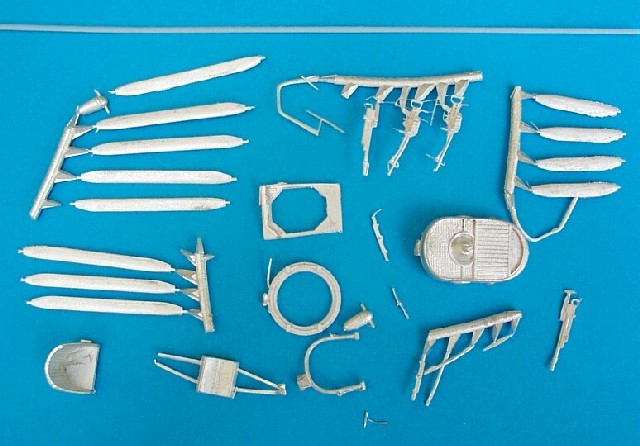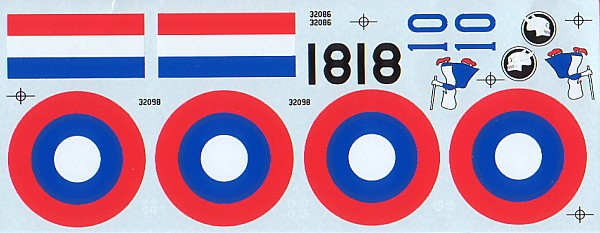Building a 1/48th scale DH4 has never been an easy task.
With only the old Aurora kit and the terrible AMT offering to choose from,
modelers have been left with a void.
Blue Max has endeavoured to fill this with their latest
release.
Paul Monteagle again provides the excellent box art for
the familiar Blue Max packaging. The expected assortment of plastic and
pewter provide the parts for the American Liberty engined version of this
famous aircraft.
Thirty four well molded parts are presented in the usual pleasant grey
plastic. The inevitable flash is seen on some components but this is very
easy to remove. Detail on the fuselage halves is very sharp and delicate.
The inner sides exhibit basic structural details and provide a good
foundation for detailing. Blue Max help here with a plastic floor, fuel
tank, instrument panels, rudders and control columns. Sprue gates have
been kept to the lower edges so that no detail is lost on cleanup.
Click the thumbnails below to view larger
images:
The wings have benefited from the new molding technique
that was first seen on the Pegasus F2B. A sprue gate is no longer part of
the leading edge, which means that the lovely rib detail is not destroyed
during cleanup. The gate now originates from the inboard mating surface. I
think that “wing ripple” will now be a thing of the past!
Trailing edges on the wings is good as is those on the
separate ailerons, with the latter needing a bit of refining with wet and
dry.
Comparison to photos would indicate that the leading edge corner of the
wing tips could do with a touch of wet and dry to round off the slight
“point”. They also show that the side edges of the rear cut out could also
be slightly more angled towards the wing tips.
Depending on which plans you believe, some modelers may decide to reshape
the tail plane outline. Whether you do this or not, thinning of the
trailing edges is a must.
The only other area I would question is that the rudder may be a little
undersize and photos show that the rudder is in need of a flat outline
near its bottom edge.
Don’t panic when you see the V12 arrangement on the engine parts. These
are only meant to be a representation to hold the exhausts, since this
area is supposed to be covered anyway.
Thirty pewter metal parts are included which are well formed and will
require only minimal sanding to get rid of seams. Sadly my example had
suffered a bit in the bag but some careful bending will put this right.

Due to the size of the struts, these have been done in
metal as opposed to the usual extruded airfoil plastic. The pewter was not
as soft as I had expected, but this is a good thing, as the superbly thin
struts will remain strong enough to handle the large wings.
Other main items the metal is used for are the nice
radiator/cowl, machine guns, scarf ring and seat.
The decals are up to the usual high standard that we have
come to expect, with the sheet showing perfect registration, good colours,
and very thin carrier film.

As the instruction state, decals solvents are not
recommended, nor needed.
Option 1
American (Dayton –Wright) DH4 “Liberty Plane” of the 50th
Observation Aero Squadron, Behonne.
It is an excellent choice by Blue Max to depict such a
famous machine, one that participated in the search for the “Lost
Battalion”. The decal sheet gives the Bleckley/Goettler aircraft as number
18 for the “Medal of Honor” deed, but I am not so sure.
The following information is based on Alan Dukota’s
excellent book “Medal of Honor Aviators of World War One”:
Bleckley and Goettler flew in two different machines on
the 6th of October 1918. In their first flight, the two men flew “number
2” (serial number 32169). Believing they had spotted the Battalion, they
volunteered for a second mission in the hope of dropping much needed
supplies. Their original aircraft was so badly shot up from enemy ground
fire that they used Lieutenant Pickrell’s “number 6” for the second
mission. It was in this aircraft (serial 32517) that they didn’t return.
The overall colour details of numbers “2” and “6” are essentially the
same. Reference to photos of these and other machines in the squadron;
reveal that other markings should be taken into account.
As well as the aircraft numbers appearing on the fuselage sides, they also
appeared on the starboard side of the top wing and underside of the lower
wing. This was as per a memorandum from the Office of Chief of the Air
Service issued on the 6th May 1918. The colour of these numbers appears
dark in photos and is thought to be red.
More squadron markings are found on the wings in the form of chevrons.
Again these appear on the upper and lower wings but on the oppose side to
the numerals.
The colours of the chevrons are believed to be blue and
red, being separated by a portion of the background colour.
More controversy is present with the Squadron insignia, the broom carrying
Dutch cleaning lady. The Office of Chief of Air Service gave out more
instructions on the 6th May. It said that no aircraft from bombing or
observation squadrons could have any distinctive insignia until “after one
month of service at the front, or immediately upon receiving citation in
orders from higher authority for distinguished services”.
Since the first mission flown by the 50th Aero over the Front was on 12th
September, it is unlikely that the “Dutch lady” insignia would have been
applied before the October 6th mission.
It is great that the insignia is present on the sheet though, as it
enables other later machines to be constructed. Also note, that generally,
photos show the roundels near the wing tips on these machines.
Option 2
American (Dayton-Wright) DH4 “Liberty Plane” of the 168th
Observation Aero Squadron, France 1918.
A more sedate scheme, that is livened up with the number
“10” and a flying skull emblem on the fuselage side.
Blue Max's 1/48 scale American DH4 is a very well produced
kit that has superior wing and fuselage moldings compared to earlier
releases. The gate attachment points have been placed in optimum positions
with no loss of part quality.
Construction photos are now included on the instruction
sheet which will greatly assist those that do not have access to more
detailed information. This all bodes well for things to come.
Bring on the Roland!
Recommended
Thanks to
Squadron.com for the review sample.
Review and Images Copyright © 2002 by
Robert Baumgartner
Page Created 18 November, 2002
Last updated 22 July, 2003
Back to HyperScale Main Page
Back to Reviews Page
Home | What's
New | Features
| Gallery |
Reviews | Reference
| Forum
| Search